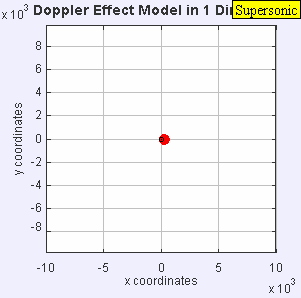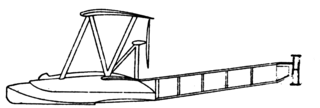a tail boom refers to part of an aircraft:
- a Helicopter tail
- Twin-boom aircraft
a tail boom refers to part of an aircraft:

A tailplane, also known as a horizontal stabiliser, is a small lifting surface located on the tail (empennage) behind the main lifting surfaces of a fixed-wing aircraft as well as other non-fixed-wing aircraft such as helicopters and gyroplanes. Not all fixed-wing aircraft have tailplanes. Canards, tailless and flying wing aircraft have no separate tailplane, while in V-tail aircraft the vertical stabiliser, rudder, and the tail-plane and elevator are combined to form two diagonal surfaces in a V layout.

A sonic boom is a sound associated with shock waves created when an object travels through the air faster than the speed of sound. Sonic booms generate enormous amounts of sound energy, sounding similar to an explosion or a thunderclap to the human ear. The crack of a supersonic bullet passing overhead or the crack of a bullwhip are examples of a sonic boom in miniature.

Aerial refueling, also referred to as air refueling, in-flight refueling (IFR), air-to-air refueling (AAR), and tanking, is the process of transferring aviation fuel from one military aircraft to another during flight. The two main refueling systems are probe-and-drogue, which is simpler to adapt to existing aircraft, and the flying boom, which offers faster fuel transfer, but requires a dedicated boom operator station.

The Caproni Ca.37 was a ground attack aircraft designed and built in Italy by Caproni around 1916

The empennage, also known as the tail or tail assembly, is a structure at the rear of an aircraft that provides stability during flight, in a way similar to the feathers on an arrow. The term derives from the French language verb empenner which means "to feather an arrow". Most aircraft feature an empennage incorporating vertical and horizontal stabilising surfaces which stabilise the flight dynamics of yaw and pitch, as well as housing control surfaces.

A vertical stabilizer or tail fin is the static part of the vertical tail of an aircraft. The term is commonly applied to the assembly of both this fixed surface and one or more movable rudders hinged to it. Their role is to provide control, stability and trim in yaw. It is part of the aircraft empennage, specifically of its stabilizers.

A twin tail is a specific type of vertical stabilizer arrangement found on the empennage of some aircraft. Two vertical stabilizers—often smaller on their own than a single conventional tail would be—are mounted at the outside of the aircraft's horizontal stabilizer. This arrangement is also known as an H-tail, as it resembles a capital "H" when viewed from rear - these were used on a wide variety of World War II multi-engine designs that saw mass production, especially on the American B-24 Liberator and B-25 Mitchell bombers, the British Avro Lancaster and Handley-Page Halifax heavy bombers, and on the Soviet Union's Petlyakov Pe-2 attack bomber.

A twin-boom aircraft is characterised by two longitudinal booms. The booms may contain ancillary items such as fuel tanks and/or provide a supporting structure for other items. Typically, twin tailbooms support the tail surfaces, although on some types such as the Rutan Model 72 Grizzly the booms run forward of the wing. The twin-boom configuration is distinct from twin-fuselage designs in that it retains a central fuselage.

The Boeing KB-29 was a modified Boeing B-29 Superfortress for air refueling needs by the USAF. Two primary versions were developed and produced: KB-29M and KB-29P.
The Friedrichshafen FF.34 was a German biplane floatplane of the 1910s produced by Flugzeugbau Friedrichshafen.

The Boeing L-15 Scout or YL-15 was a small, piston engine liaison aircraft built by Boeing in very small numbers after World War II. It was a short take-off and landing (STOL) aircraft powered by a 125 hp Lycoming engine. The L-15 was an attempt by Boeing to expand its product line as World War II drew to a close, and Boeing's production of combat aircraft declined. Boeing decided against marketing the L-15 as a general aviation aircraft, and the twelve that were produced went to the United States Army for testing, then were transferred to the United States Fish and Wildlife Service in Alaska for various duties.

In the United States, all military aircraft display a serial number to identify individual aircraft. These numbers are located on the aircraft tail, so they are sometimes referred to unofficially as "tail numbers". On the Northrop Grumman B-2 Spirit bomber, lacking a tail, the number appears on the nose gear door. Individual agencies have each evolved their own system of serial number identification. Aircraft serials are part of the Aircraft Visual Identification System, which also includes the aircraft's tail code and Modex.
The DB-LK was a bomber aircraft designed and built in the USSR in 1939.

The Stout Skycar was a series of four one-off American light aircraft of the 1930s.

The Fieseler Fi 168 was a projected German ground attack aircraft designed in 1938 by Frederik Kassel, who created the aircraft after a request from the Technisches Amt of the RLM Reichsluftfahrtministerium -.

The Arado Ar E.340 was a twin-engined dive- and tactical-medium bomber, designed by Arado Flugzeugwerke at the request of the Reich Air Ministry in 1939 to compete for a production contract for the Bomber B fast bomber design competition, but the project was cancelled.

The Zeppelin-Lindau Rs.II was a biplane flying boat, designed by Claudius Dornier and built during 1914–1915 on the German side of Lake Constance. Initially this aircraft was powered by three engines mounted inside the hull driving three pusher propellers via gearboxes and shafts. The later version was powered by four engines in two push-pull nacelles mounted between the wings.
The Akaflieg Stuttgart fs28, nicknamed Avispa is a single engine, twin boom pusher configuration light sports and utility aircraft designed at the University of Stuttgart in West Germany in the 1970s. Unusually, it has an inverted V-tail. The sole example remained active as of 2010.

The 1993 Llyn Padarn helicopter crash occurred on 12 August 1993, when an RAF Westland Wessex helicopter, serial number XR524, with 3 crew and 4 passengers on board suffered a catastrophic tail rotor failure and plunged into Llyn Padarn, a lake in North Wales. Three passengers perished.

The SNCAC NC.1070 was a piston engined attack and torpedo bomber designed and built in France shortly after World War II. The second prototype, the NC1071, was the first French multi-jet turbine powered aircraft.